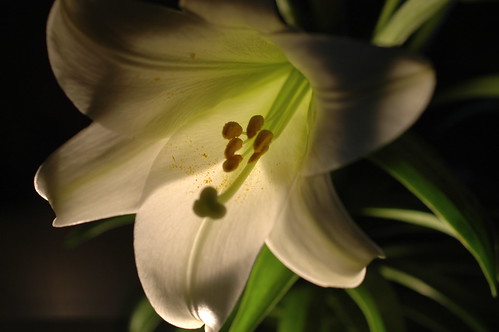Easter Lily by **Mary**
Easter is coming and so are the Easter Lilies-Lilium longiflorum. Did you know that ten growers, most located along the California-Oregon border, produce 95 percent of all bulbs grown in the world for the potted Easter lily market?
If you purchase an Easter Lily plant, check to see that it is a healthy plant. At home, keep your lily away from drafts and drying heat sources such as appliances or heating ducts. Bright, indirect light is best with daytime indoor temperatures of 65 to 75° F. Water the plant only when the soil feels dry to the touch. NEVER over water. Pour out any water in the saucer under the plant. To prolong the life of the blossoms, remove the yellow anthers (pollen-bearing pods) found in the center of each flower. See here.
On this Easter Sunday…. by calamityjan2008
Easter Lilies are one of the loveliest flowers and the fragrance is ambrosial so one hates to discard the plant when it stops blooming. Since Easter Lilies are forced to bloom at Easter time in hothouses by professionals, they are difficult to keep in pots at home for another season of bloom. But you might have some success if you plant the bulb outside after the plant finishes blooming. Remember that forced blooms are not always successful for replanting. But it is worth the try.
Do not attempt to plant outdoors until it is warm enough; which means there is no frost in the ground. Remove the dead flowers and, until the time is ready to plant outdoors, keep the plant in an indirect, sunny window and water thoroughly when slightly dry. Don’t let the plant sit in water or the bulb may rot.
Select a bright sunny, well draining spot in the garden to plant the bulb. Amend the soil with compost or other organic matter. Lilies like a neutral soil with a pH of 6.5 to 7. The wonder of compost is that it is neutral.
Remove the plant from the container and loosen the root system. There will be some torn roots, but it is better for the plant to loosen the root than leave the compacted root system it has in the container. Set the top of the bulb six-inches below the soil surface – the top two inches should be organic mulch to keep the roots cool . Cut off any remaining old flowers, but leave the stem and leaves. Soon after planting if the old top withers and dies, you can cut this back. This is no cause for alarm because new shoots will soon emerge. But if it does not wither and die, do not cut back the stem and leaves. Water thoroughly and fertilize with an all-purpose garden fertilizer or blood meal and continue watering and fertilizing for the remainder of the season as you would other garden plantings.
When the leaves and stem dies down in the fall, then cut it off at the soil surface. After the soil surface freezes in late fall, mulch the soil and do not remove the mulch until new growth begins in the spring. The lily will not bloom again the same year it is planted because it needs 1,000 hours of cold so the flower buds can form again. The plant may rebloom the second summer in June or take a few more years for buds to set. To keep the plant alive, if you don’t live in extreme cold winters, the added mulch on top of the plant should insulate the plant through the winter. However in states like Wyoming where the winters are too cold, the bulbs should be dug up in the fall and placed with moist peat moss in a container that holds moisture. Keep the bulbs in a refrigerator at 40 degrees Fahrenheit until spring. Those who left the bulbs in the ground should remove the added mulch next spring when all signs of frost are gone and new growth begins. You can start applying a balanced fertilizer as soon as new growth appears and monthly in the spring and summer until the lily blooms. Easter Lilies bloom in June/July, so don’t look for flowers next Easter. Once it has established itself, treat the Easter lily like any other lily.
Happy Easter! by swisscan
Just remember that the success rate will vary, as with all florist plants that have been forced into bloom. But since it is possible to get it to rebloom, what have you got to loose?
Some gardeners have good results when overwintering lilies although they are not reliably hardy. To improve your chances for overwintering success, mulch the plants with at least 4″ of straw in the fall. Another option is to dig the bulb in the fall and store indoors the same way we do other tender bulbs such as canna.



